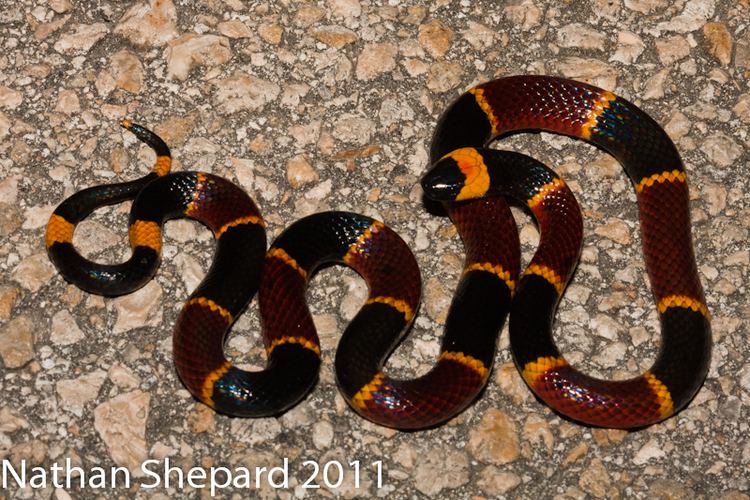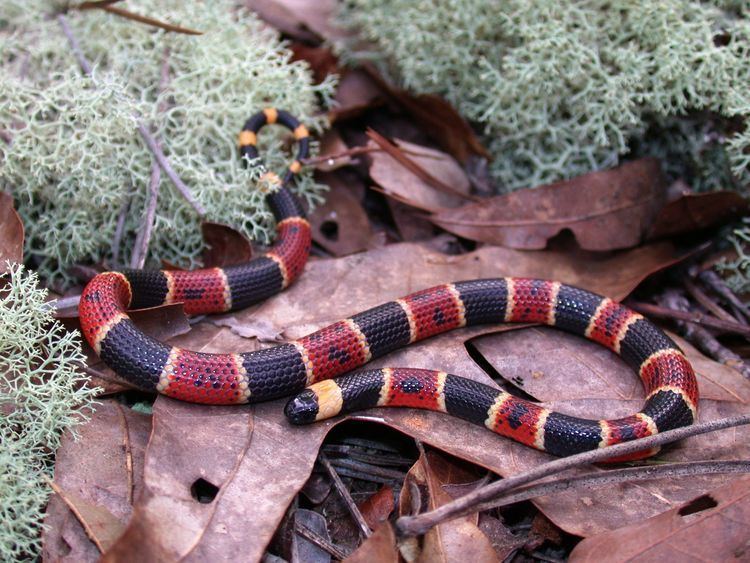Rank Species | Phylum Chordata Suborder Serpentes Genus Micrurus Higher classification Micrurus | |
 | ||
Similar Snake, Micrurus, Reptile, Elapidae, Micrurus tener | ||
Micrurus fulvius, the Eastern coral snake, common coral snake, American cobra, or more, is a species of venomous elapid snake endemic to the southeastern United States. It should not be confused with the scarlet snake (Cemophora coccinea) or scarlet kingsnake (Lampropeltis elapsoides), which are harmless mimics. No subspecies are currently recognized.
Contents
- Coral snake in the wild micrurus fulvius field herping
- Description
- Common names
- Geographic range
- Habitat
- Feeding
- Reproduction
- Venom
- References

Coral snake in the wild micrurus fulvius field herping
Description

Generally less than 80 cm (31 in) in length, its maximum reported length of 121.8 cm (48.0 in) was for a specimen in Florida (Niell, 1958) and 129.5 cm (51.0 in) (Roze, 1996). Males have longer tails than females, but females reach a greater total length.

The dorsal scales are smooth in 15 rows. The ventral scales number 197-217 in males and 219-233 in females. There are 40-47 subcaudals in males and 30-37 in females. The anal plate is divided.

The color pattern consists of a series of rings that encircle the body: wide red and black rings separated by narrow yellow rings. The head is black from the rostral to just behind the eyes. The red rings are usually speckled with black. People who live in its natural range are often taught a folk rhyme as children: "Red next to black, safe from attack, red next to yellow, you're a dead fellow," or "Red touching black, friend of Jack; red touching yellow, you're a dead fellow". The rhyme is useful in teaching children to distinguish king snakes (Lampropeltis ssp.), which are considered helpful predators of vermin such as rats and mice, from this much more dangerous snake that should only be handled by an experienced biologist or herpetologist. However, this rhyme is only applicable to the North American species, and cannot be used reliably in the Caribbean, or Central or South America.
Common names

Among the many common names for this snake are the eastern coral snake, American cobra, candy-stick snake, common coral snake, coral adder, Elaps harlequin snake, Florida coral snake, harlequin coral snake, North American coral snake, red bead snake, thunder-and-lightning snake, and, in Spanish, serpiente-coralillo arlequín (lit. "harlequin coral snake").
Geographic range

This snake is found in the Southeastern United States from southeastern North Carolina, south through South Carolina and peninsular Florida, and westward through southern Georgia, Alabama and Mississippi to southeastern Louisiana, on to central Texas, and has been spotted as far west as Ozona, Texas. It may be found at altitudes of near sea level to about 400 m (1,300 ft).
Habitat
Micrurus fulvius occurs in upland mesophytic and tropical hammocks in Florida, as well as glade land, high pine, scrub oak and live oak hammock, slash pine and wiregrass flatwoods. In southern Georgia and Florida, it is found in dry areas with open ground that are bushy but not heavily vegetated. It is associated with sandy ridges in Mississippi and sandy creek bottoms in Louisiana. It is rarer in North and South Carolina, but is more typically found there in the scrub oak forests and pitch pine habitats near the coast, as well as the coastal plain of the southeast.
Feeding
They eat lizards, frogs, and smaller snakes.
Reproduction
Females are reported to lay 3-12 eggs in June that hatch in September. Neonates are 18–23 cm (7.1–9.1 in) in length.
Venom
Bites and fatalities are very rare. Only two documented fatalities were attributed to this species in the 1950s, and only one has been reported since Wyeth antivenin became available for it in the 1960s. The most recent fatality attributed to the eastern coral snake occurred in 2006 (confirmed in 2009 report). The victim failed to seek proper medical attention and died several hours after being bitten, becoming the first fatality caused by M. fulvius in over 40 years.
M. fulvius does not account for many cases of snakebite in the U.S., with only about 100 bites each year. The snake is considered secretive and generally reluctant to bite (its venomous potential was still being debated in the 1880s), and envenomation (i.e., secretion of venom during a strike) is thought to occur in only 40% of all bites. But unlike New World pit vipers, this New World coral snake cannot control the amount of primarily neurotoxic venom injected. Dry bites often result from a near miss or deflection; although the venom an adult coral snake holds is enough to kill up to five adults, it cannot release all its venom in a single bite. Historically, however, the mortality rate was estimated to be about 10–20%, with death occurring in as little as one to two hours, or as much as 26 hours after the bite. This is not that surprising, since the LD100 for humans is estimated to be 4–5 mg of dried venom, while the average venom yield is 2–6 mg with a maximum of more than 12 mg. This is probably why current standard hospital procedure in the U.S. is to start with antivenin therapy for coral snake bites, even if there are no symptoms yet (since there may not be any noticeable, localized symptoms).
Wyeth discontinued the manufacture of coral snake antivenin in 2010, citing a lack of profitability. Pfizer has also decided to halt production of its antivenin for similar reasons (see Coral snake antivenom shortage).
